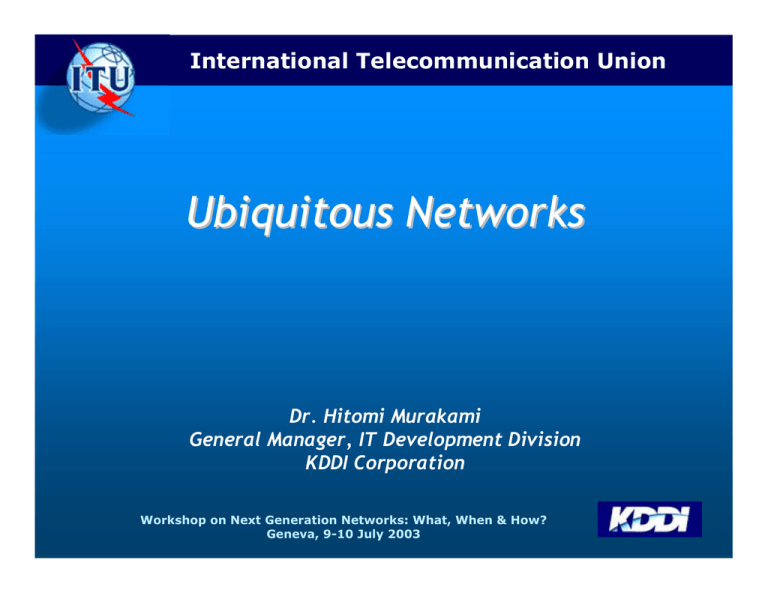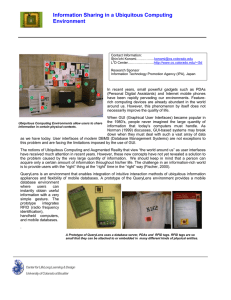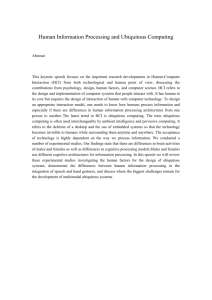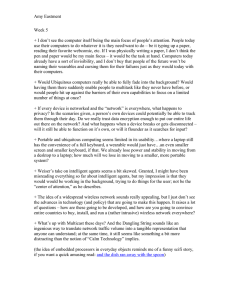Ubiquitous Networks International Telecommunication Union Dr. Hitomi Murakami General Manager, IT Development Division
advertisement

International Telecommunication Union Ubiquitous Networks Dr. Hitomi Murakami General Manager, IT Development Division KDDI Corporation Workshop on Next Generation Networks: What, When & How? Geneva, 9-10 July 2003 Table of Contents ITU-T 1. Overview of ubiquitous networks 1.1 Our future life with ubiquitous networks 1.2 Development into ubiquitous networks 2.3 Impact on NGN 2. Technologies supporting ubiquitous network 2.1 WiFi and future wireless technologies 2.2 RFID Tag 2.3 Context awareness 3. Security Issues 4. Conclusion Appendix: Introduction on Japanese activities 9-10 July 2003 Workshop on Next Generation Networks: What, When & How? 2 1. ITU-T Overview of ubiquitous networks o Ubiquitous network consists of innumerable number of computing devices embedded in almost everything around us, platforms and networks that interconnect them, and user devices that make use of and act on the available information. Ubiquitous Devices IPv6 Smart objects (RFID tags) Cameras Sensors ・ 9-10 July 2003 Networks & Platforms User Devices Wireless LAN PDAs Infrared Bluetooth Mobile NW ・ Location Information Optical Core NW ・ ・ ・ ・ PCs Mobile Phones Wearable PCs Home Electronics (TV set, VCR, Air-conditioner, etc) Vehicles ・ Workshop on Next Generation Networks: What, When & How? 3 1. Overview of ubiquitous networks 1.1 ITU-T Our future life with ubiquitous networks o When fully implemented around 2010, Ubiquitous Network will change our daily life by providing us with the information and services we need with less efforts. Office • Collaboration with other group within a company and with suppliers and customers can reduce cost from fluctuating supply and demand. • Create new business from real-time and location-based commerce. Urban areas • Routing support to permit seamless roaming among networks and media types by maintaining active TCP/UDP connections. • Provide location-aware and personalized advice for vehicle drivers. Location-aware Personalized advice Ubiquitous Network Public facilities • Real-time congestion and weather information-based traffic management can increase road capacity. • Monitoring secular change of road and building could prevent accidents caused by incidents and natural disasters. 9-10 July 2003 Multimedia conference Automatic meeting minutes Searchable notes Home • The home is constantly monitored using audio and video observation methods, and even monitors its inhabitants’ medical conditions. • Support social connections of elderly people promoting peace of mind for the Food/recipe management family. On-line ordering Kitchen monitoring Workshop on Next Generation Networks: What, When & How? 4 1. Overview of ubiquitous networks 1.2 Development into ubiquitous networks ITU-T o As the ubiquitous network evolves, it will add new entities such as home electronic appliances, followed by various things around us embedded with RFID tags. Scale of network connections billion 100 Drastic increase in the number of network connections as the network evolves. Clothes Books Documents Parcels 10 Home electronic appliances Brand name products Marketable securities ・Cheques ・Gift coupons Communications devices 1 Present 9-10 July 2003 Connections extended to various things with RFID tags 2005 2010 Workshop on Next Generation Networks: What, When & How? 5 1. Overview of ubiquitous networks 1.3 ITU-T Impact on NGN o Ubiquitous networks will create new and huge demands for communications owing to : 1) New Internet access method: As broadband access and services prevail, television sets and VCR/DVD recorders will be connected to the network, creating additional requirements for capacity. 2) Home electronic appliances: In a few years, common electronic appliances such as air conditioners, microwave ovens, refrigerators, etc, will be connected to the network. 3) M2M communications: While the demands for person oriented (P2P and P2M) communications will someday saturate due to the limitation in the number of subscribers, M2M communications between thousands of RFID tags (smart objects) will create new and unprecedented amount of demands. NGN should support the capacity and functions/technologies to handle communications demands created by ubiquitous networks. 9-10 July 2003 Workshop on Next Generation Networks: What, When & How? 6 2. Technologies supporting ubiquitous network ITU-T 2.1 WiFi and future Wireless technologies Wireless technologies play an important role in ubiquitous networks. o Wireless avoids plug and unplug problems. o Wireless permits easy use of installed local infrastructure. annual volume of shipment Emerging new technologies and market trends accumulated volume of shipment WiFi hot spot networks o 802.11b has made itself a dominant technology for hot spot. o 802.11a and 11g technologies are in tiptoe. o Bluetooth will be complementary. o WiFi operators will incorporate into cellular networks and billing. Multi hop networks o P2P wireless, self-configuring, selfhealing networks. o Ease saturation in densely populated area. 4G networks o Japanese operators, DoCoMo and KDDI, announced 4G experiments, services around 2010. 9-10 July 2003 Volume of shipment 25,000,000 20,000,000 15,000,000 10,000,000 5,000,000 2001 2002 2003 2004 2005 2006 Year Estimated volume of shipment: WiFi equipments in Japan Workshop on Next Generation Networks: What, When & How? 7 2. Technologies supporting ubiquitous network 2.2 RFID Tags (Radio Frequency Identification) ITU-T RFID tags will play a major roll in ubiquitous networks. o Being very small, they can be embedded in numerous household goods around us, and can make them part of the network. o Their communications capability allow them to be managed and controlled from the network, thereby supporting our daily life. Core Network Contents Server Access Point Contents Server Grocery Books Packets Home Electronics Appliances PC/PDA RFID (Radio Frequency Identification) tag 9-10 July 2003 Workshop on Next Generation Networks: What, When & How? 8 2. Technologies supporting ubiquitous network 2.2 RFID Tags ITU-T Numbering and Addressing of RFID o ID’s have two functions: (1) To identify an object/product in the real world — RFID tags are embedded in every object/product in the real world. — The ID written into an RFID tag notifies the network of the identity and property of the object/product. (2) To serve as an address/number to uniquely identify the location of an entity on the network — Two or more entities on the network can communicate with each other using the ID (address) o Assignment of ID’s should be such that they associate an object in the real world with its virtual address on the network. o Development and standardization required in the area of: — Assignment and management of ID’s — Length of ID codes — Security and privacy considerations 9-10 July 2003 Workshop on Next Generation Networks: What, When & How? 9 2. Technologies supporting ubiquitous network 2.2 RFID Tags ITU-T Ubiquitous Address Management o Properties of ubiquitous devices such as functions and services, physical location, are registered with central or distributed servers. o Services are available by searching for an address having a set of properties that matches the user’s requirements. Devices are networked to perform the service requested. Ubiquitous Addressing Layer Ubiquitous Address Networking Search by <Name of Services、 、 Functions、 、Location> Ubiquitous Address Search Ubiquitous Address Distributed Management Central Server Ubiquitous Address Management Network Layer FA FA FA IP Address Hardware Address Adhoc network 9-10 July 2003 Centralized Management Next Generation Mobile Network Fixed Network Workshop on Next Generation Networks: What, When & How? 10 2. Technologies supporting ubiquitous network 2.2 RFID Tags Application of RFID Tags ITU-T (1) Health information management o Daily management of nutrition information is bothersome. o Automatic nutrition control by using RFID tags (smart objects) on dishes may contribute to health care and improve revenue/expenses balance of the national health insurance. RFID tags with food ID, weight, etc. Calorie Nutrition balance Health advice On dish microchip On dish microchip Food nutrition DB 9-10 July 2003 On dish microchip Health Information Server Calculate nutrition value Workshop on Next Generation Networks: What, When & How? 11 2. Technologies supporting ubiquitous network 2.2 RFID Tags Application of RFID Tags (2) RFID Tag on Books ITU-T o Japanese publishers considering to embed RFID tags on every book they publish, starting around 2005. o The purposes are twofold:o Inventory control at publishers, warehouses, delivery and stores o Prevention of shoplifting (to replace magnetic tags) Shoppers can inquire online if books of his/her interest are in stock. 9-10 July 2003 New books are registered with the store’s inventory system on delivery from publishers Automatic ○ Check-out Unchecked books × are detected at exit Workshop on Next Generation Networks: What, When & How? 12 2. Technologies supporting ubiquitous network 2.3 ITU-T Context Awareness Context is the information about the circumstances of a user. To provide the user with a service of his or her needs in the ubiquitous network, it is essential that the network has the knowledge of his or her context. o Location and time are simple examples of context. User needs: Applications that are context aware and allow personalization based on his or her interest. Context aware applications: o can capture the context, o assign meaning to it, and o change behavior accordingly. Opportunities for business: Billing by location, time, users’ age; and timely geo-dependent advertising. 9-10 July 2003 Workshop on Next Generation Networks: What, When & How? 13 2. Technologies supporting ubiquitous network 2.3 Context awareness ITU-T Navigation and location-aware communications Role of navigation Two key functions Not always essential, BUT o Position (Where am I?) o Enables geo-dependent service provision o Navigation (How do I get from A o Potentially the greatest profit to B?) Now o Position = Personalization = Revenue Applications of navigation Soon o Information on local restaurants, hotels, taxis o Tourist information o Web sites of interest, hobbies o Geo-dependent advertising o Multimedia navigation/tracking services o Regional/local personalized portals Location-aware communications realizes: Seamless, interactive, intelligent access to multimedia information to support transport, business and leisure needs at the user location. 9-10 July 2003 Workshop on Next Generation Networks: What, When & How? 14 2. Technologies supporting ubiquitous network 2.3 Context awareness ITU-T Application of location-aware communications (1) Pedestrian ITS o Provide pedestrians including elderly and disabled people with an environment where they can move in a safe, comfortable and convenient way using ITS technology. o System includes PLGPS (pseudo satellites), Bluetooth roadside devices, map database and communication networks. GPS Satellite High precision longitude/latitude info Internet PLGPS PLGPS Street Light Contents servers Gateway Roadside device Traffic info, navigation, warnings & alerts Personal Mobile Terminal Roadside controller Bluetooth Fiber optic cable 9-10 July 2003 Pedestrian ITS Network Workshop on Next Generation Networks: What, When & How? 15 ITU-T 2. Technologies supporting ubiquitous network 2.3 Context awareness Application of location-aware communications (2) Fleet Management Support for: o Delivery Service, o Field Maintenance Service, and o Medical Service. Company Benefits o Reduce operational costs o Increase worker and fleet productivity o Manage and control inventory o Manage vehicle and driver performance o Increase asset utilization Location of the target terminal (person) and its traced trajectory is shown on the Web. Mobile Terminal GPS Satellites Driver Advantages o Simplify and automate paperwork o Improve work efficiency o Enhance safety and security Internet Internet Mobile Mobile Network Network 9-10 July 2003 Workshop on Next Generation Networks: What, When & How? 16 3. Security Issues Privacy Dilemma ITU-T How do we manage the following tradeoffs? 1. Ubiquity - Who has access to my resources and services? Issues for confidentiality, authorization and access control. 2. Context Awareness - Who else knows where I am and what’s going on around me? Matters for privacy and controlled information access including and beyond location. 3. Invisible Computer - Who am I interacting with and when? Defining suitable authentication and trust frameworks for ubiquitous communications. 4. Smart Items (RFID)– They are so small, can they protect themselves and who owns these things anyway? Public Emergency Collaborative games Privacy Dilemma Personal exposure history Fashion preference Private Body geometry Individual 9-10 July 2003 Location commerce Collaborative surgery Health maintenance Collaborative Workshop on Next Generation Networks: What, When & How? 17 4. ITU-T Conclusions Ubiquitous networks redefine the human/computer relationship. The following are key issues for further consideration. o Development of ubiquitous networks requires collaborative efforts of academia, government, industry and network operators. • Open standard • Privacy awareness o Full deployment of ubiquitous networks will take time, and promotion of advanced technologies is indispensable. • Evolution • Partial understanding • Experimentation For a ubiquitous world to come true, it is essential to: o Collaboratively develop, deploy and implement ubiquitous network technologies, and o Design regulatory strategy to meet new and innovative business needs. 9-10 July 2003 Workshop on Next Generation Networks: What, When & How? 18 Appendix: Introduction on Japanese activites Ubiquitous Networking Forum ITU-T Established on 11 June 2002, this Japan based forum seeks the following objectives:1. R&D and standardization of ubiquitous network technology 2. Liaison and coordination with outside bodies and organizations related to ubiquitous network 3. Promotion and enlightenment concerning ubiquitous network, including support for research and experimental trial Organizational information: Administrator Chairperson: Tadao Saito Ph.D, Emeritus Professor, University of Tokyo Vice-Chairpersons: Ken Sakamura Ph.D, Professor, University of Tokyo Tomonori Aoyama Ph. D, Professor, University of Tokyo Secretariat The Telecommunication Technology Committee (TTC) Members Academia, telecommunication operators, broadcasters, electronics manufacturers, contents providers, and so on URL (Japanese contents only) http://www.ubiquitous-forum.jp/ 9-10 July 2003 Workshop on Next Generation Networks: What, When & How? 19





